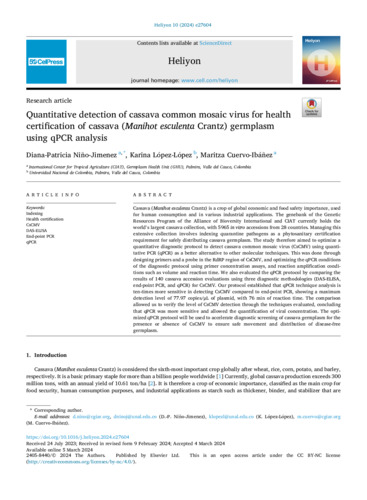Quantitative detection of cassava common mosaic virus for health certification of cassava (Manihot esculenta Crantz) germplasm using qPCR analysis
Cassava (Manihot esculenta Crantz) is a crop of global economic and food safety importance, used for human consumption and in various industrial applications. The genebank of the Genetic Resources Program of the Alliance of Bioversity International and CIAT currently holds the world's largest cassava collection, with 5965 <i>in vitro</i> accessions from 28 countries. Managing this extensive collection involves indexing quarantine pathogens as a phytosanitary certification requirement for safely distributing cassava germplasm. The study therefore aimed to optimize a quantitative diagnostic protocol to detect cassava common mosaic virus (CsCMV) using quantitative PCR (qPCR) as a better alternative to other molecular techniques. This was done through designing primers and a probe in the RdRP region of CsCMV, and optimizing the qPCR conditions of the diagnostic protocol using primer concentration assays, and reaction amplification conditions such as volume and reaction time. We also evaluated the qPCR protocol by comparing the results of 140 cassava accession evaluations using three diagnostic methodologies (DAS-ELISA, end-point PCR, and qPCR) for CsCMV. Our protocol established that qPCR technique analysis is ten-times more sensitive in detecting CsCMV compared to end-point PCR, showing a maximum detection level of 77.97 copies/μL of plasmid, with 76 min of reaction time. The comparison allowed us to verify the level of CsCMV detection through the techniques evaluated, concluding that qPCR was more sensitive and allowed the quantification of viral concentration. The optimized qPCR protocol will be used to accelerate diagnostic screening of cassava germplasm for the presence or absence of CsCMV to ensure safe movement and distribution of disease-free germplasm.

